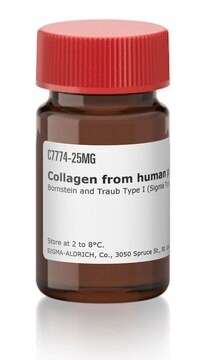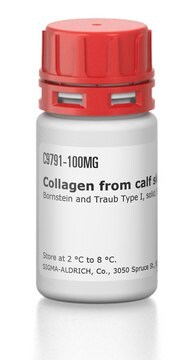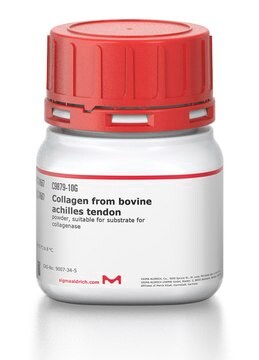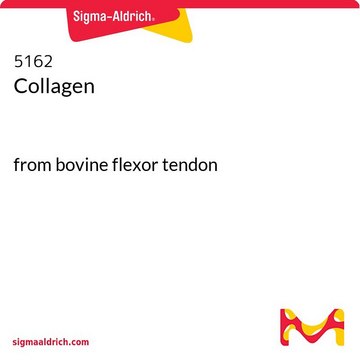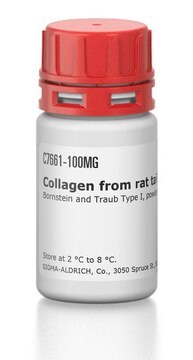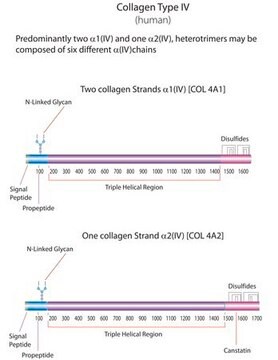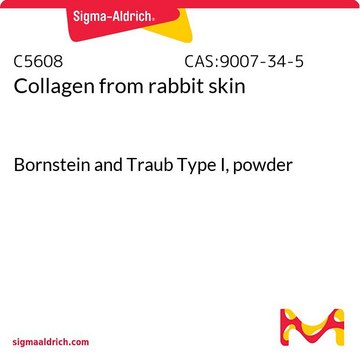C5483
Human Collagen Type I
from human placenta, powder, ~95% (SDS-PAGE), suitable for cell culture
Sign Into View Organizational & Contract Pricing
All Photos(2)
About This Item
Recommended Products
Product Name
Collagen human, Bornstein and Traub Type I, acid soluble, powder, ~95% (SDS-PAGE)
biological source
human
Quality Level
Assay
~95% (SDS-PAGE)
form
powder
technique(s)
cell culture | stem cell: suitable
solubility
aqueous acid: ≤5 mg/mL
UniProt accession no.
storage temp.
2-8°C
Gene Information
human ... COL1A2(1278)
Looking for similar products? Visit Product Comparison Guide
General description
Collagen type 1 alpha 2 (COL1A2) encodes pro-alpha2 chain and is a component of heterodimer, type 1 collagen fiber. It is mapped to human chromosome 7q21.3. COL1A2 associates with COL1A1 in the ratio 1:2 and undergoes posttranslational modification to form mature type I collagen fibre.
Collagen is classified into a number of structurally and genetically distinct types. We use the nomenclature proposed by Bornstein and Traub. Do not confuse Sigma type designations with recognized collagen classification types.
Application
Collagen type I may be used in research of Idiopathic pulmonary fibrosis (IPF). Robust expression of collagen-type I is one distinctive feature of IPF. Additionally, collagen-type I has been used in studies on the effect of endoplasmic reticulum (ER) stress from IPF on myofibroblastic differentiation of lung fibroblasts. Collagen-type I soluble in acidic solution produces three dimensional scaffolding useful in bioengineering and cell culture applications where biomaterials are needed to replace native collagen extracellular matrices.
Collagen Type I has been used as a scaffold for the growth in vitro of stem cells in a wide variety of biomaterial engineering studies.
Collagen Type I has been used as a scaffold for the growth in vitro of stem cells in a wide variety of biomaterial engineering studies.
Human collagen has been used:
- as a component of extracellular matrix in the chemotaxis assay of the rat adipose-derived stem cells
- in adhesion assay of the adult retinal pigmented epithelium-19 (ARPE-19) cell line
- in the glycation aggregation and adsorption studies as a model system for arthritis
Biochem/physiol Actions
Collagen type 1 alpha 2 (COL1A2) is crucial for bone formation, cartilage and blood vessels. Imbalance in COL1A2 may be the cause for dental fluorosis. Missense mutations involving glycine substitutions in the COL1A2 gene alters the collagen triple helix structure decreasing its stability and is implicated in osteogenesis imperfecta. Mutations near the splice site of COL1A2 gene results in exon skipping and is associated with Ehlers-Danlos Syndrome. An insertion or deletion polymorphism in the COL1A2 gene impairs its interaction with microRNA and modulates the bone mineral density resulting in high susceptibility to osteoporosis.
Preparation Note
Prepared from human skin by modification of Gallop, P.M.
Storage Class Code
11 - Combustible Solids
WGK
WGK 1
Flash Point(F)
Not applicable
Flash Point(C)
Not applicable
Personal Protective Equipment
dust mask type N95 (US), Eyeshields, Gloves
Choose from one of the most recent versions:
Already Own This Product?
Find documentation for the products that you have recently purchased in the Document Library.
Customers Also Viewed
Structural models of osteogenesis imperfecta-associated variants in the COL1A1 gene
Mooney SD and Klein TE
Molecular and Cellular Proteomics, 1(11), 868-875 (2002)
Rare autosomal recessive cardiac valvular form of Ehlers-Danlos syndrome results from mutations in the COL1A2 gene that activate the nonsense-mediated RNA decay pathway
Schwarze U, et al.
American Journal of Human Genetics, 74(5), 917-930 (2004)
Integrin activation or alpha9 expression allows retinal pigmented epithelial cell adhesion on Bruch?s membrane in wet age-related macular degeneration
Afshari FT, et al.
Brain, 133(2), 448-464 (2010)
Mutation analysis of the COL1A1 and COL1A2 genes in Vietnamese patients with osteogenesis imperfecta
Duy BH, et al.
Human Genomics, 10(1), 27-27 (2016)
Gene expression of collagen type I alpha 2 and its relationship with dental fluorosis.
Gastelbondo-Pastrana B, et al.
Journal of Oral Research, 7(6), 172-175 (2018)
Our team of scientists has experience in all areas of research including Life Science, Material Science, Chemical Synthesis, Chromatography, Analytical and many others.
Contact Technical Service